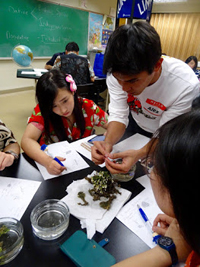
Six competitively selected undergraduate students in the science, technology, engineering and math (STEM) program at Kapiʻolani Community College are preparing to meet their 12 peers from Kansai University, Takatsuki Campus, Japan during a 10-day shared exchange in August. While in Japan, the students will work as a team to investigate local and global environmental issues. The students’ travel to Japan is just one part of the innovative year-long Kai Yama Program.
The Kai Yama program integrates environmental science research, community service and cultural exchange using online collaborative technologies and two shared site visits. Travel from Hawaiʻi to Japan is made possible by a grant from the Japan-United States Friendship Commission. Kapiʻolani CC’s Pathways Coordinator Kelli Goya and biology and ecology Associate Professor Wendy Kuntz, have worked closely with colleagues in Japan—Kenichi Kubota, Bert Kimura and Mary Kimura—to ensure that students study research methodology, exchange ideas and culture, and provide community service, all to actively address conservation and sustainability challenges.

Exploring Hawaiʻi’s environmental challenges
During spring break 2016, the Kapiʻolani students and Kansai’s students worked together in a joint investigation into the environmental challenges faced in Hawaiʻi, working closely with Mālama Maunalua, a community-based, non-profit stewardship organization committed to conserving and restoring a healthy and productive Maunalua Bay. Students provided community service and removed more than 800 pounds of invasive algae. They also conducted research on the impacts of removing invasive algae on species composition. Over the 10-day visit, students forged fast friendships and were able to share their own cultures and exchange ideas on how to best address both local and global environmental issues.
“I learned that Hawaiʻi and Japan have similar environmental problems,” said Kapiʻolani student Esther ʻAlohi Madrona. “When we share our problem-solving solutions, maybe we can help each other.”
Continuing work in Japan
This month, the collaboration will continue in Japan with a joint investigation in the small mountain village of Kuta in the Sakyo district. Students will also be introduced to the ecology of the area, including nearby Lake Biwa, and the environmental issues facing the local community, primarily non-native species, and human-wildlife conflicts. Students from Kapiʻolani will work side-by-side with the Kansai University students to provide service to a community-based ecological project for Kuta village.
All of Kapiʻolani’s student participants are considering a STEM degree in environmental science or a related field, and all are either at the freshman or sophomore level. Five students are Native Hawaiian, a traditionally under-represented group in the STEM fields.
“The Kai Yama project provides opportunities for students to affirm their chosen degree pathway through community engagement projects,” said Goya. “Students are applying what they are learning in the classroom to solve local and global environmental community issues. These learning experiences help motivate students to persist toward their degree.”
—By Louise Yamamoto

